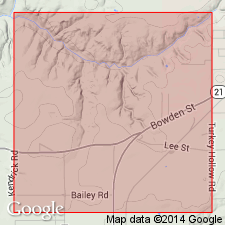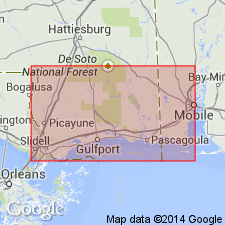
- Usage in publication:
-
- Frisco City sand
- Modifications:
-
- First used
- Dominant lithology:
-
- Sand
- AAPG geologic province:
-
- Mid-Gulf Coast basin
Summary:
Name Frisco City sand introduced for interval in the lower Haynesville Formation of the AL subsurface. Composed of moderately to well-sorted sand, very fine to fine-grained, subarkose to plagioclase arkose, with angular pebbles of chlorite and mica schists. Interbedded with thinly bedded, burrowed sandy mudstone. Noted for hydrocarbon production. Thickness greater than 100 ft [estimated from cross-section]. Overlies Buckner Anhydrite Member of Haynesville. Age is Jurassic.
Source: GNU records (USGS DDS-6; Reston GNULEX).

- Usage in publication:
-
- Frisco City Formation/sand
- Modifications:
-
- Areal extent
- AAPG geologic province:
-
- Mid-Gulf Coast basin
Summary:
Frisco City Formation identified in several wells in the Wiggins arch of MS. Unit recognized through correlation with the Mobil USA well, Harrison Co, where it is 200 ft thick. The Frisco City had only been recognized previously in the most up-dip Smackover trend, from Monroe to Covington Co., AL. Described as granite wash with very poor sorting. Clasts are fresh, broken, quartz and feldspar crystals. Primary cements are calcite and hematite. Well developed oolites are dispersed within the granite wash. Alluvial fan depositional environment. Underlies Haynesville and overlies Buckner anhydrite in the Mobil USA well; overlies the Smackover in the Conoco Higgins well and is much thinner. Age is Oxfordian.
Source: GNU records (USGS DDS-6; Reston GNULEX).
For more information, please contact Nancy Stamm, Geologic Names Committee Secretary.
Asterisk (*) indicates published by U.S. Geological Survey authors.
"No current usage" (†) implies that a name has been abandoned or has fallen into disuse. Former usage and, if known, replacement name given in parentheses ( ).
Slash (/) indicates name conflicts with nomenclatural guidelines (CSN, 1933; ACSN, 1961, 1970; NACSN, 1983, 2005, 2021). May be explained within brackets ([ ]).

